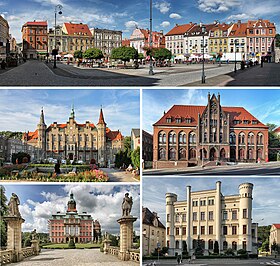Wałbrzych
| Wałbrzych | |||
|---|---|---|---|

Main sights in Wałbrzych
|
|||
|
|||
| Coordinates: 50°46′N 16°17′E / 50.767°N 16.283°ECoordinates: 50°46′N 16°17′E / 50.767°N 16.283°E | |||
| Country | Poland | ||
| Voivodeship | Lower Silesian | ||
| County | city county | ||
| Established | 9th century | ||
| City rights | 1400 to 1426 | ||
| Government | |||
| • Mayor | Roman Szełemej | ||
| Area | |||
| • Total | 84.70 km2 (32.70 sq mi) | ||
| Elevation | 350 m (1,150 ft) | ||
| Population (31 December 2010) | |||
| • Total | 120,197 | ||
| • Density | 1,400/km2 (3,700/sq mi) | ||
| Time zone | CET (UTC+1) | ||
| • Summer (DST) | CEST (UTC+2) | ||
| Postal code | 58-300 to 58-309, 58-316 | ||
| Area code(s) | +48 74 | ||
| Car number plates | DB, DBA | ||
| Website | www |
||
Wałbrzych [ˈvau̯bʐɨx] (German: ; Lower Silesian: Walmbrig or Walmbrich; Czech: Valbřich or Valdenburk) is a city in Lower Silesian Voivodeship in southwestern Poland. From 1975–1998 it was the capital of Wałbrzych Voivodeship; it is now the seat of Wałbrzych County. Wałbrzych lies approximately 70 kilometres (43 mi) southwest of the voivodeship capital Wrocław and about 10 kilometres (6 miles) from the Czech border.
According to the city's official website, the early Polish name of the settlement was Lasogród ("forest castle"). The German name Waldenburg (also meaning "forest castle") referred to the castle Nowy Dwór (German: Burg Neuhaus), whose ruins stand south of the city; the name came to be used for the entire settlement. It first appeared in the 15th century, coming from the words Wald (forest) and Berg (mountain) later associated with the castle. The modern Polish name "Wałbrzych" comes from the German name Walbrich, a late medieval linguistic variation of the older names "Wallenberg" or "Walmberg".
Polish sources indicate the city's predecessor, Lasogród, was an early medieval Slavic settlement whose inhabitants engaged in hunting, honey gathering, and later agriculture. Lasogród eventually developed into a defensive fort, the remains of which were destroyed in the 19th century during expansion of the city. However, some German sources say no archaeological or written records support notions of an early Slavic settlement or the existence of a castle before the late 13th century, and that during the Middle Ages the area was part of the unpopulated Silesian forest (Polish: Silesian Przesieka; German: Schlesischer Grenzwald). According to 17th-century Polish historian Ephraim Naso, Wałbrzych was a small village by 1191. This assertion was rejected by 19th-century German sources and by German historian Hugo Weczerka, who says the city was founded between 1290 and 1293, and was mentioned as Waldenberc in 1305. He places the city near Nowy Dwór (German: Neuhaus), built by Bolko I the Strict of the Silesian Piasts. The city website, however, cites the building of the castle as a separate event in 1290. A part of Nowy Dwór castle, a manor built in the 17th century, was destroyed in the 19th century.
...
Wikipedia



